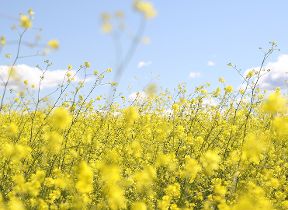When is hay fever season in the UK?
Tree pollen occurs first, typically from late March to mid-May. Grass (which actually has two peaks) lasts from mid-May until July, and weed pollen covers the end of June to September.
Tree pollen occurs first, typically from late March to mid-May, and affects around 25% of people. Most people are allergic to grass pollen (which actually has two peaks) and the season lasts from mid-May until July. Weed pollen can be released at any time but the season typically covers the end of June to September.
However, dependent upon where you live in the UK, the hay fever season will start at different times. For example, there’s a later start and shorter season in the north of the UK, where generally there is less pollen. Urban areas have lower counts than the countryside, and places inland have higher counts than around the coast.
If we look at grass pollen, the peak across England and Wales, for example, usually starts in the first two weeks of June. There are two peaks though, with the second, lower peak occurring in the first two weeks of July, after which things tail off slowly.
These peaks may be masked by how wet, dry, warm or cold it is, and the timing of the peaks very much depends on the weather during spring and early summer.
There are also loads of factors that change the start date of the pollen season. Low temperatures in winter will keep plants and trees dormant for longer into the new year. Essentially, the lower the temperature the less pollen is produced, but, this can change if soil and air temperatures in spring are higher than normal.
Spring rainfall is also key, as a dry season reduces the amount of pollen production. Regardless of the weather, pollen is also dependent on how hardy different species are and how well they cope with a mixture of different types in one region.
How does the weather affect hay fever?
The weather plays a significant role in the production, distribution and dispersion of pollen.
Rain, wind, temperature and sunshine all affect how much pollen will be produced and how much it will be dispersed.
Rainfall
Any rainfall causes a marked decrease in pollen concentration in the air, but the time and amount that it rains during the day is very important. Early, heavy and prolonged rain is likely to keep counts low all day whereas rain in the afternoon will have less of an impact.
Temperature
Temperature plays an important part in the release of pollen.
- For grass, a maximum temperature between 18 - 28 °C could give a high count if it’s a dry day with low humidity and a gentle breeze.
- Trees respond best when the temperature range is between 13 - 15 °C.
However, if the temperature rises above 28 °C then all pollen levels decrease. If several warm days occur in a row, then the supply of pollen can run out altogether.
Wind
When it comes to wind then it all gets a bit more complicated. If the wind is too light the pollen will barely get off the ground to be dispersed, but if it is too windy, the pollen gets blown further afield and thins out significantly. Different types of pollen will need different wind speeds for ideal dispersion but Birch pollen, for example, needs moderate to high winds.
Sunlight
The amount of daylight, or the “photoperiod”, is also crucial to pollen production because of photosynthesis. If there is a particularly cloudy spell of weather then plants and trees will produce less pollen because they are getting less light.
What will climate change do to pollen patterns in the UK?
It’s likely a changing climate will impact pollen patterns in at least three ways:
- A changing climate will mean that changes in temperature and rainfall may lengthen the UK pollen season and potentially make pollen concentrations higher.
- It’s possible that climate change will lead to changes in the potency of pollen – a single pollen particle can have varying amounts of the allergy-causing agent on it.
- The UK is also facing a threat from changes in the geographical distribution of allergenic plants, due to climate change, with invasive species such as ambrosia (common ragweed) being on the watch list. A single ragweed plant can produce a billion grains of pollen per season and its pollen causes strong allergic reactions.





